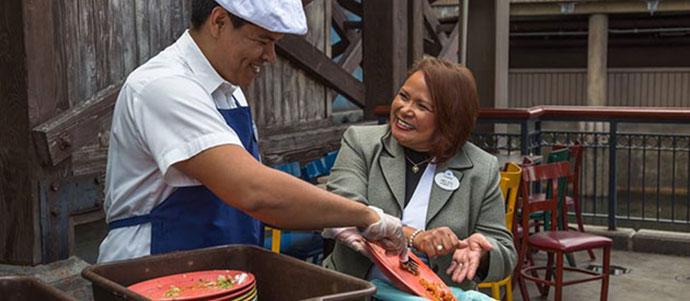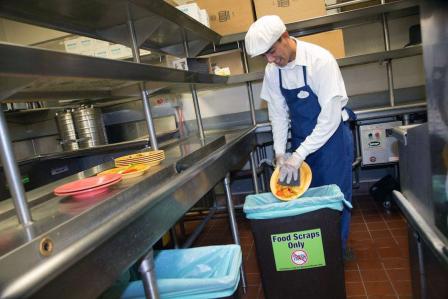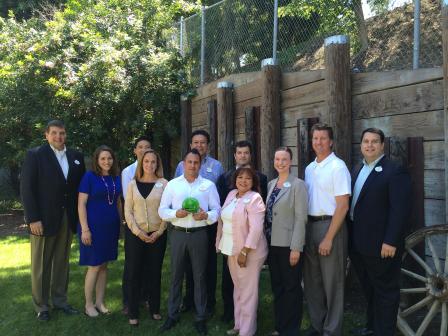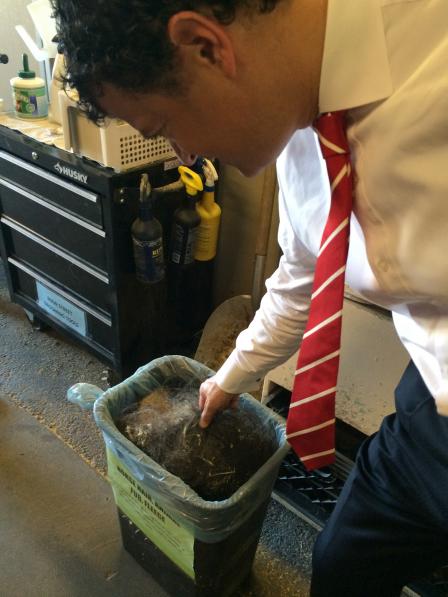EPA Honors Disneyland Resort for Achievements in Food Recovery
EPA Honors Disneyland Resort for Achievements in Food Recovery
 Event Photographs
Event PhotographsDisneyland Resort has been recognized by EPA with the 2014 Food Recovery Challenge award for its zero waste efforts, and the highest percent increase in food recovery of any theme park in the nation.
"Disneyland is a model for food recovery efforts," said Jared Blumenfeld, EPA's Regional Administrator for the Pacific Southwest. "Disney has the potential to educate millions of people who visit the resort on zero waste, while doing its part to fight climate change and create a better environment for southern California residents."
EPA's Food Recovery Challenge partners with organizations and businesses to prevent and reduce food waste. The participants include groups such as grocers, educational institutions, sports and entertainment venues, restaurants, and hotels. The program helps participants save money, reduce hunger in communities, and protect the environment by purchasing less, donating extra food, and composting.
"I am so proud that our Cast Members are being recognized for their creative approach to keeping the environment top of mind," said Jon Storbeck, vice president of Resort Hotels and Downtown Disney, who also leads environmental integration efforts at Disneyland Resort. "The Disneyland Resort is honored to continue Walt Disney's legacy of conservation stewardship, and even more proud to build upon it with programs such as these."
In December 2014, Disneyland Resort began a surplus food donation program. In the first three months, it donated 3,800 pounds of prepared, unserved food from restaurants and banquets at the Disneyland Hotel to Second Harvest Food Bank of Orange County for distribution to people in need within the community. The resort also donates surplus, pre-packaged food from its merchandise locations to local food banks. It has donated more than 110,000 pounds of packaged food, valued at $360,000.
Sixty Disneyland Resort locations participate in the Food Scraps Diversion Program including facilities at Disneyland Park, Disney California Adventure Park, Downtown Disney, Disneyland Hotel, Disney's Paradise Pier Hotel, and Disney's Grand Californian Hotel & Spa. Food scraps are separated and collected both pre- and post-consumer by Disneyland Resort Food & Beverage Cast Members. Food scraps collected at the resort are picked up by a local vendor who processes them into feed nutrients for farm animals.
Accomplishments
As part of its efforts under the Food Recovery Challenge, the Disney Resort has:
- Diverted more than 7 million pounds of food scraps from entering landfills, including a 694% increase of surplus food donation to people from 2012 to 2013
- Increased its donation of food scraps to animal feed by 1880% from 2012 to 2013.
- Converted 626 tons of on-site used cooking oil from Resort restaurants to on-site biodiesel, which fuels the Disneyland Railroad and Mark Twain Riverboat and has reduced the resort's consumption of petroleum-based diesel by about 150,000 gallons per year.
- Achieved a 99.8% diversion rate for its Circle D Corral, the first in The Walt Disney Company or any theme park. Circle D Corral collects animal waste, hay scraps, and wood shavings, as well as coffee grounds from resort restaurants, and laundry lint from hotel clothes dryers, producing 600,000 pounds of compost per year.
35 Million Tons of Food
In 2012, Americans threw away nearly 35 million tons of food; that's more than any other type of material being put in landfills. As wasted food decomposes in a landfill, it generates methane, a greenhouse gas 25 times more potent than carbon dioxide.
The U.S. Department of Agriculture estimates that wasted food costs America more than $165 billion annually and that the average family of four throws away $1,600 worth of food each year.
Through innovation and hard work, Food Recovery Challenge participants and endorsers have greatly reduced wasted food. Food pantries, food rescue programs, local food banks, soup kitchens and shelters are benefitting from donations of wholesome and nutritious food — helping feed people, not landfills.




